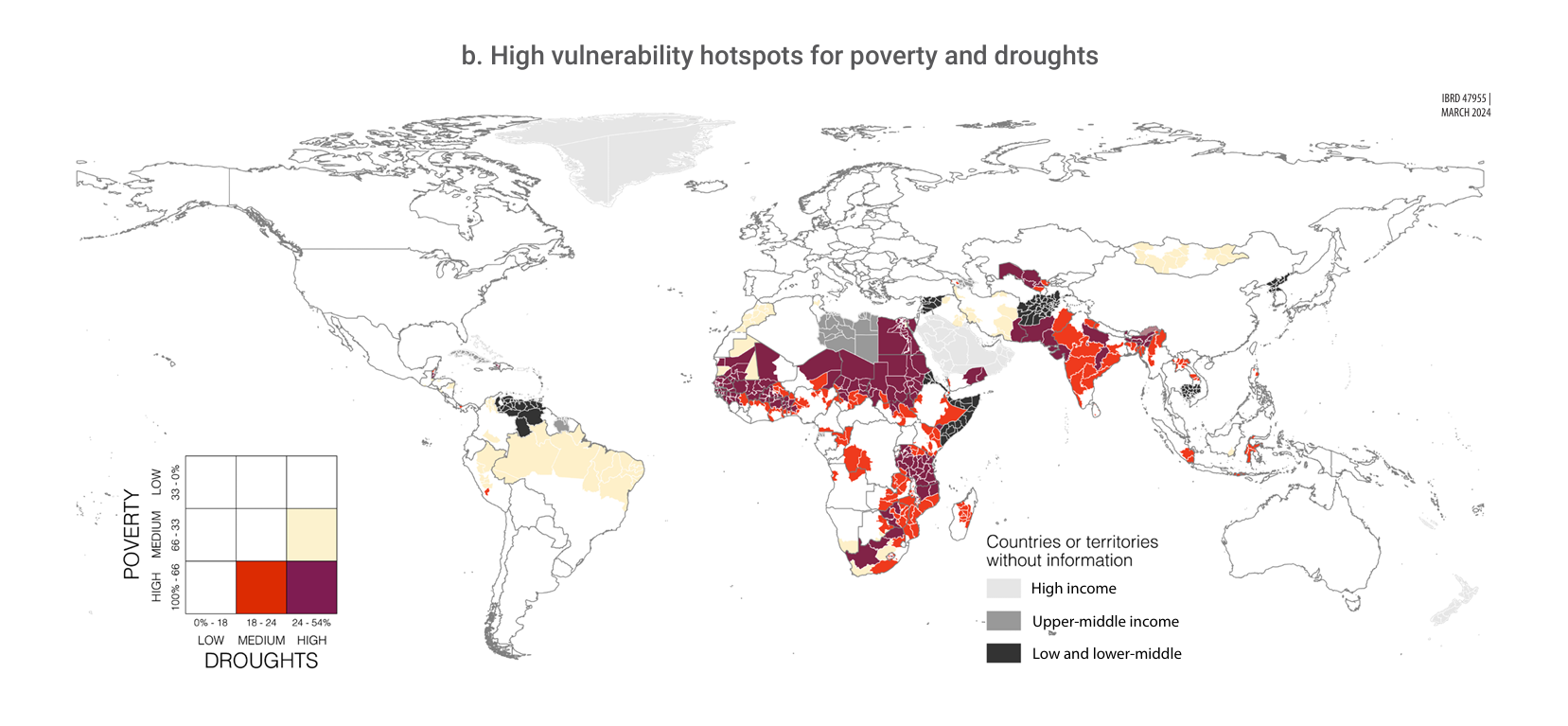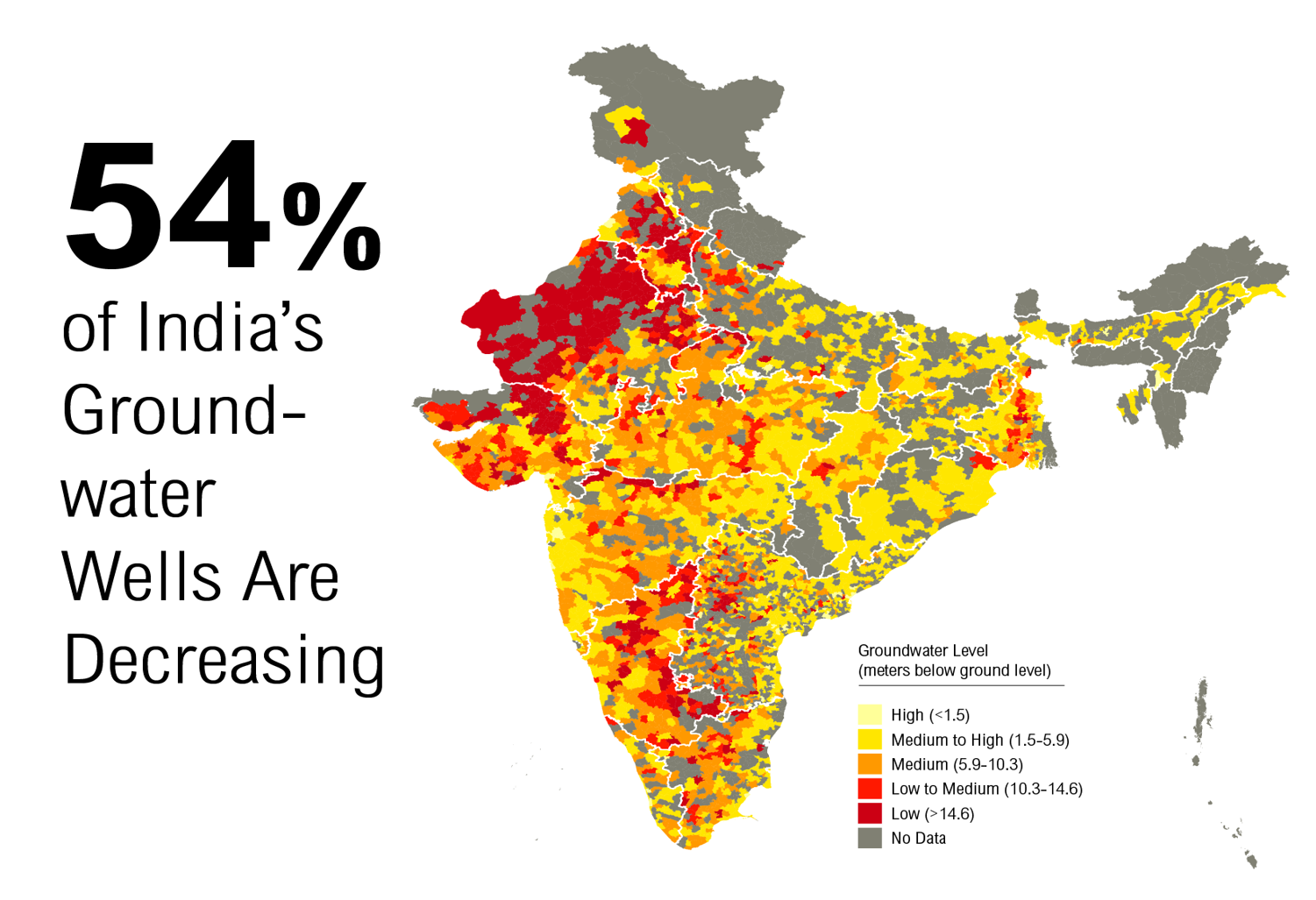World Bank Report on Global Water Crisis | 24 May 2024
For Prelims: World Water Forum, Swachh Bharat Mission, Jal Jeevan Mission, Jal Kranti Abhiyan, World Bank, Atal Bhujal Yojana
For Mains: Issues of Global Water Scarcity, Steps Taken to Address the Challenges.
Why in News?
The World Bank's new report "Water for Shared Prosperity," released at the 10th World Water Forum in Bali, Indonesia, highlights the alarming global water crisis and its implications for human and economic development worldwide.
What are the Key Highlights of the Report?
- Alarming Water Scarcity Statistics:
- Significant gaps exist in access to water and sanitation services globally. As of 2022, 2.2 billion people lack access to safely managed drinking water services and 3.5 billion lack access to safely managed sanitation.
- Eight out of ten people without basic drinking water and sanitation services reside in rural areas.
- Significant gaps exist in access to water and sanitation services globally. As of 2022, 2.2 billion people lack access to safely managed drinking water services and 3.5 billion lack access to safely managed sanitation.
- Regional Disparities in Access to Water:
- Disparity in Freshwater Distribution: China and India, with 36% of the global population, hold only 11% of freshwater, while North America, with 5% of the population, possesses 52%.
- Africa and Asia: The Democratic Republic of the Congo holds over half of Africa’s water resources, yet regions like the Sahel, Southeastern Africa, and South and Central Asia remain water-stressed.
- Low-Income Countries: These regions have seen a regression in access to safe drinking water, with an additional 197 million people lacking access since 2000.
- Marginalised Groups: Disparities in access also affect marginalized groups based on gender, location, ethnicity, race, and other social identities.
- Impact of Climate Change:
- Climate change intensifies water-related risks, with developing countries facing more severe and prolonged droughts and floods.
- Over 800 million people are at high risk of drought, and twice as many live in flood-prone areas.
- By 2100, meteorological drought is projected to impact 15% more of the global land area, increasing to nearly 50% when considering temperature effects.
- Central Europe, Asia, the Horn of Africa, India, North America, Amazonia, and central Australia will be the most affected.
- Poor populations are more exposed to water-related risks and have limited capacity to adapt, perpetuating a cycle of poverty.
- Climate change intensifies water-related risks, with developing countries facing more severe and prolonged droughts and floods.
- Human Capital and Economic Growth:
- Access to water and sanitation services is crucial for educational attainment and overall human capital development.
- In low-income countries, 56% of jobs are in water-intensive sectors, which are highly sensitive to water availability.
- In Sub-Saharan Africa, 62% of employment is in water-dependent jobs, with low rainfall significantly impacting GDP growth.
- Access to water and sanitation services is crucial for educational attainment and overall human capital development.
- Social Cohesion and Conflict:
- Effective and equitable water management fosters community trust and cooperation, whereas mismanagement can exacerbate conflicts.
- Proper water resource management contributes to peace and social cohesion by promoting inclusivity and reducing tensions.
- Recommended Interventions for Sustainable Water Management:
- Strengthening resilience to hydro-climatic risks for the poorest populations is crucial.
- Better development, management, and allocation of water resources are necessary.
- Promoting equitable and inclusive delivery of water services is essential for reducing poverty and increasing shared prosperity.
- Strengthening resilience to hydro-climatic risks for the poorest populations is crucial.
World Water Forum 2024
- The 2024 World Water Forum (10th WWF) is under the theme of Water for Shared Prosperity and is jointly organised by the Government of the Republic of Indonesia and the World Water Council.
- The World Water Council, established in 1996 and located in Marseille, is an international organisation with 260 member organisations from 52 countries including India.
- Its mission is to gather the international community to advocate for water as a political priority for sustainable and equitable development of the planet.
- The World Water Council, established in 1996 and located in Marseille, is an international organisation with 260 member organisations from 52 countries including India.
- The Forum is the world's largest event organised, since 1997, every three years with a different host country.
- The Forum provides a unique platform for the water community and key decision-makers to collaborate and make long-term progress commitments on global water challenges to provide clean and fair water for all.
What is the Extent of Water Scarcity in India?
- India’s Water Crisis: According to the "Composite Water Management Index" report by NITI Aayog (National Institution for Transforming India), India is facing its worst water crisis with nearly 600 million people experiencing high to extreme water stress.
- Additionally, 8 million children below the age of 14 in urban India are at risk due to poor water supply.
- The report also states that India ranks 120th out of 122 countries in the water quality index, with almost 70% of water being contaminated.
- Disproportionate Water Resources: India has only 4% of the world's freshwater resources, despite housing a staggering 18% of the global population. This imbalance creates immense strain on available water.
- Strained Water Availability:
- Declining Groundwater Levels: The 5th Minor Irrigation Census conducted by the Ministry of Jal Shakti shows that there are 20.52 million wells in the country, including dug wells, shallow tube wells, medium tube wells, and deep tube wells.
- India relies heavily on groundwater, but extraction rates exceed replenishment. This leads to rapidly declining water tables, raising concerns about future availability.
- A 2019 Central Ground Water Board report indicates critical or over-exploited groundwater levels in many areas.
- Drying Rivers and Reservoirs: Seasonal changes and unsustainable water usage cause rivers and reservoirs to dry up, particularly before the monsoon arrives.
- This disrupts water flow and access, especially in the summer months.
- Declining Groundwater Levels: The 5th Minor Irrigation Census conducted by the Ministry of Jal Shakti shows that there are 20.52 million wells in the country, including dug wells, shallow tube wells, medium tube wells, and deep tube wells.
- Threat to Agriculture and Food Security:
- High Water Consumption: Agriculture accounts for a significant portion of India's water usage. The current water scarcity threatens food security and agricultural productivity.
- Expected Demand-Supply Gap: A potential demand-supply gap of up to 570 billion cubic metres by 2030 in the agricultural sector alone. This gap could lead to food shortages and price hikes.
- A 2019 World Bank report estimates that water scarcity in India could lead to a 50% decline in agricultural productivity by 2050
- Economic Consequences: A report by NITI Aayog suggests that water scarcity could cost India up to 6% of its GDP by 2050 if left unaddressed.
- Impact of Climate Change on Water Scarcity:
- Monsoon Rainfall: India's lifeline, the monsoon season, is becoming increasingly erratic. Studies by the Indian Institute of Tropical Meteorology (IITM) show a decline in average monsoon rainfall by 10% since the 1950s.
- Evaporation Rates: Rising global temperatures due to climate change lead to higher evaporation rates.
- A study published in Nature found that the volume of water loss (evaporation volume) of India’s natural lakes and reservoirs (artificial lakes) increased at a rate of 5.9% per decade during 1985-2018.
- Increased evaporation further reduces surface water availability, drying up rivers, and lakes, and depleting soil moisture, crucial for agriculture.
- Glacier Melt: The Himalayas, a source of major rivers like the Ganges and Indus, are experiencing rapid glacial melt. While initial melt may seem beneficial, it disrupts natural water flow patterns.
- Water Crisis in Southern India: The southern states of India, including Karnataka, Tamil Nadu, Andhra Pradesh, and Telangana, observed a severe water crisis due to very low water levels in major reservoirs.
- Most major reservoirs in these states are filled to only 25% of their capacity or even less, with some notable dams filled to 5% or less.
- This is primarily due to lower rainfall caused by El Niño events, leading to drought-like conditions and prolonged dry periods.
- Additionally, delayed monsoon and post-monsoon deficiency have also contributed to the depletion of water levels.
What are India’s Initiatives Related to Water Conservation?
- Atal Mission for Rejuvenation and Urban Transformation (AMRUT).
- Sahi Fasal campaign.
- Swachh Bharat Mission.
- Jal Jeevan Mission.
- Jal Kranti Abhiyan.
- National Water Mission.
- National Rural Drinking Water Programme.
- NITI Aayog Composite Water Management Index.
- Jal Shakti Abhiyan.
- Atal Bhujal Yojana..
- National Water Policy, 2012.
- Pradhan Mantri Krishi Sinchayee Yojana.
- Atal Bhujal Yojana.
- Per Drop More Crop.
Way Forward
- Micro-Irrigation Techniques: Drip irrigation and sprinklers can significantly reduce water usage in agriculture, a major water consumer.
- Rainwater Harvesting: Storing rainwater in tanks and other structures can provide a sustainable water source for homes and communities.
- Desalination: Treating seawater for use can provide a reliable water source in coastal areas, though energy consumption needs to be addressed.
- Treating wastewater for irrigation or other non-potable uses reduces pressure on freshwater sources.
- Nature-Based Solutions: Invest in restoring wetlands and natural water bodies. Healthy ecosystems naturally purify water and replenish groundwater reserves.
- Water ATMs: Develop "Water ATMs" - vending machines providing treated water via prepaid cards to offer clean water in underserved areas and encourage responsible water usage through a pay-per-use system.
- Climate-Smart Agriculture: Adopting agricultural practices that are more resilient to climate change, such as drought-resistant crops, can help mitigate the impact of water scarcity.
- Public Awareness Campaigns: Educating people about water conservation and promoting responsible water use behaviours are crucial for long-term solutions.
|
Drishti Mains Question: Q. Analyse the regional disparities in access to water resources and the impact of climate change on water-related risks, especially in developing countries. Suggest measures to address these challenges. |
UPSC Civil Services Examination, Previous Year Question (PYQ)
Prelims
Q. With reference to ‘Water Credit’, consider the following statements: (2021)
- It puts microfinance tools to work in the water and sanitation sector.
- It is a global initiative launched under the aegis of the World Health Organisation and the World Bank.
- It aims to enable the poor people to meet their water needs without depending on subsidies.
Which of the statements given above are correct?
(a) 1 and 2 only
(b) 2 and 3 only
(c) 1 and 3 only
(d) 1, 2 and 3
Ans: (c)
Mains
Q. Suggest measures to improve water storage and irrigation system to make its judicious use under the depleting scenario. (2020)


